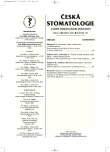Changes in the Shape of Lower Dental Arch after Treatment with Fixed Appliance
Změna tvaru dolního zubního oblouku ortodontickou léčbou fixním aparátem
Cíl:
Postihnout tvarové změny dolního zubního oblouku po terapii fixním aparátem u extrakční a neextrakční léčby.
Soubor:
Modely dolního zubního oblouku - 122 pacientů léčených fixními aparáty straight-wire, rozdělených do 3 skupin podle způsobu léčení: neextrakční léčba v dolní čelisti doplněná event. strippingem; neextrakční léčba se sagitální expanzí více než 2 mm a plánovanou změnou tvaru oblouku (převislý skus); extrakce dvou dolních premolárů.
Metoda:
Na scanneru zhotoveny okluzogramy dolního zubního oblouku před nasazením a po sejmutí aparátu. Na zobrazeních digitalizovány dobře identifikovatelné anatomické body na zevní křivce perimetru (12 bodů, po extrakcích 10 bodů). Ke statistice tvarových změn použita metoda EDMA (Euclidean Distance Matrix Analysis). Doplněno lineárními parametry zubního oblouku v mm a vizualizací tvaru postižením perimetru křivkou.
Výsledky:
U všech skupin došlo ke statisticky významné (p < 0,05) změně tvaru ve smyslu zúžení („zašpičaťění“) křivky perimetru. Největší průměrné významné změny tvaru jsou lokalizovány v krajině řezáků. Původní průměrná mezišpičáková šířka se u všech skupin nevýrazně zmenšila.
Závěr:
1. Společným efektem terapie fixním aparátem straight-wire byla u sledovaného souboru změna tvaru dolního zubního oblouku ve smyslu zužování křivky perimetru při současném prodlužování a prohlubování anteriorního segmentu perimetru. 2. Změny tvaru se realizovaly převážně v krajině řezáků (relace řezáků k ostatním zubům). 3. Relativní zúžení křivky bylo u neextrakční terapie podmíněno sagitálním prodloužením a v menší míře transverzálním zúžením křivky. 4. U extrakční terapie se křivka zúžila prohloubením anteriorního perimetru (anteriorní sagitální délky oblouku), přičemž průměrná mezišpičáková šířka se klinicky významně nezměnila.
Klíčová slova:
tvar zubního oblouku – geometrická morfometrie – ortodontická léčba
Authors:
M. Kotas
Authors‘ workplace:
Klinika zubního lékařství LF UP, Olomouc
přednosta prof. MUDr. M. Eber, CSc.
Published in:
Česká stomatologie / Praktické zubní lékařství, ročník 107, 2007, 4, s. 101-107
Overview
Aim:
To find out changes in the shape of lower dental arch after the extraction and nonextraction treatment with straight-wire appliance immediately after removal of the appliance.
Subjects:
Plaster casts of lower dental arch of 122 patients treated with the straight-wire appliances were classified into three groups according to the treatment: Group I (n=51): nonextraction treatment in the lower dental arch, possibly supplemented with stripping, with or without extraction in upper dental arch; Group II (n=21): non-extraction treatment with planned modification of the arch shape (namely Angle II/2); Group III (n=50): extraction of two lower premolars.
Method:
Occlusograms of the lower dental arch were made by scanner at the beginning and at the end of active treatment. Landmarks on the outer curve of the perimeter were digitized (12 points, after extractions 10 points). Euclidean Distance Matrix Analysis (EDMA) - type Form Difference Matrix (FDM) was employed to compare the arch form before and after treatment. EDMA is a coordinate-free statistical procedure that compared two forms using all the possible linear distances between homologous landmarks. Form matrices for each form are compared to identify the linear distances that are most and least different (Tmax/min). The differences are expressed as ratios in the form difference matrix. The statistical method used to test the results is the nonparametric bootstrap (in this study as p-value; α = 0.05). For FDM calculation the programme WinEDMA was used. The disadvantage of the method is that the results can be hardly represented in diagrams, therefore simplified visualisation of the result by curve fitting are used, which is not a part of EDMA method. The basic linear parameters of the dental arch were found: intermolar width, intercanine width, and the sagittal length of the arch and length of anterior part the arch in absolute values, i.e. characteristic changes in the size. The length was found indirectly with trigonometric method. A paired t-test was used to find out statistical of significance importance of the changes.
Results:
1. The arch curves are visualized with curve fitting, the superimposition was made at first molars, central incisors, and geometrical centre to allow geometrical interpretation. 2. All groups exhibit a statistically significant (p<0.05) change in the shape: relative tapering of the perimeter curve. EDMA statistics Tmax/min were after non-extraction treatment 1.084 total and 1.086 anteriorly, after expansion treatment 1.163 and 1.149, after extraction treatment 2.225 and 1.140). 3. Intercanine width decreased to – 0.67 ± 1.26 mm after non-extraction treatment, to – 0.57 ± 1.48 mm after expansion treatment and to – 0.45 ± 1.49 mm after extraction treatment.
Conclusions:
1. A common effect of treatment with the straight-wire appliances was the change in the lower dental arch shape, i.e. tapering of the perimeter curve and elongation and/or deepening of anterior segment of the perimeter. 2. The changes of the shape occurred mainly in incisors (the relationship of incisors to other teeth). 3. In the non-extraction treatment, the relative constriction of the curve occurred mainly as a consequence of the sagittal elongation and transversal narrowing of the curve. 4. In the extraction treatment the curve was constricted mainly due to the anterior perimeter deepening (the anterior sagittal arch length increased), while the intercanine width was not clinically remarkably changed.
Key words:
dental arch shape - geometric morphometrics - orthodontic treatment
Labels
Maxillofacial surgery Orthodontics Dental medicineArticle was published in
Czech Dental Journal

2007 Issue 4
- What Effect Can Be Expected from Limosilactobacillus reuteri in Mucositis and Peri-Implantitis?
- The Importance of Limosilactobacillus reuteri in Administration to Diabetics with Gingivitis
Most read in this issue
- Methods of Vital Pulp Therapy – Direct Pulp Capping
- The Use of FRC Retention Splint in Orthodontic Patient in Magnetic Resonance Examination
- Adhesive Systems in Prevention of Dental Caries
- Determination of the Risk of Caries Origin in Early Childhood
